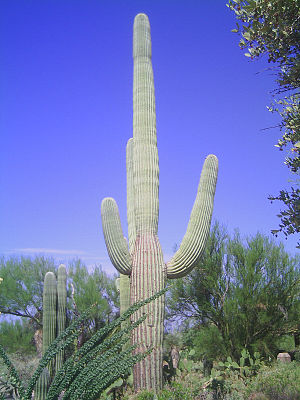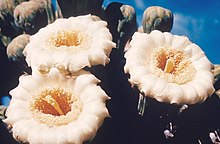Carnegiea gigantea
| Carnegiea gigantea | ||||||||||||
|---|---|---|---|---|---|---|---|---|---|---|---|---|

Carnegiea gigantea |
||||||||||||
| Systematics | ||||||||||||
|
||||||||||||
| Scientific name of the genus | ||||||||||||
| Carnegiea | ||||||||||||
| Britton & Rose | ||||||||||||
| Scientific name of the species | ||||||||||||
| Carnegiea gigantea | ||||||||||||
| ( Engelm. ) Britton & Rose |
Carnegiea gigantea is the only plant species of the monotypic genus Carnegiea inthe cactus family (Cactaceae). The botanical name honors the American industrialist and philanthropist Andrew Carnegie . The specific epithet refers to the great height of the species. Trivial names are " Saguaro " or " Sahuaro ". The German Cactus Society , the Society of Austrian Cactus Friends and the Swiss Cactus Society voted Carnegiea gigantea “Cactus of the Year 2017”.
description
The plants are very large, columnar stem succulents with a very shallow root system and a few branches that only form at an advanced age. The main rungs are about 12 to 15 m (sometimes up to 20 m) and 30 to 70 cm thick. The branches, which are several meters high, are kept upright. The brown areoles standing on the twelve to 24 rounded ribs are about 2 to 2.5 cm apart. The areoles arise from twelve or more, 1 to 2 cm long, radial spines and three to six strong, up to 7 cm long central spines. At the height of the plant, the gray thorns become shorter and finer.
The flowers formed by the areoles near the apex are 8 to 12 cm long and open up to a diameter of 12 cm. Their bracts are white to cream-colored. The fruits formed after fertilization are 6 to 9 cm long, lightly felted on the outside and sometimes have one to three thin thorns on the areoles. When ripe , the fruits turn red inside and out and open from the tip. The very many (up to 4000) seeds , about 2 mm in size, are black.
distribution
Carnegiea gigantea is distributed in the United States in the state of Arizona and in the south of the state of California west of the Colorado River and in the Mexican state of Sonora in the Sonoran Desert at altitudes of 180 to 1350 meters.
Particularly large stocks are in the highlands of Arizona and near Tucson as well as in Saguaro National Park .
Systematics
External system
The genus Carnegiea is classified within the family of the cactus plants in the tribe Pachycereeae . Molecular genetic studies showed that the genus Carnegiea is closely related to the genus Pachycereus :
| Subtribe Pachycereinae |
|
||||||||||||||||||||||||||||||||||||||||||||||||||||||||||||
|
|
Internal system
George Engelmann proposed the provisional name Cereus giganteus in 1848 . The first description followed four years later. Nathaniel Lord Britton and Joseph Nelson Rose put the species in the new genus Carnegiea .
A synonym of the genus is Rooksbya (Backeb.) Backeb. Synonyms of the species are Pilocereus giganteus (Engelm.) Rümpler (1886) and Pilocereus engelmannii Lem. (1862).
ecology
The flowering time at the locations of the plants is May to June, shortly before the beginning of the rainy season . The flowers open about two hours after sunset and then stay open until noon the next day. The pollinators are next to some insects , the flowers bat southern long-nosed bat and birds like the dove Zenaida asiatica , the hummingbirds costae Calypte , Archilochus alexandri and Cynanthus latirostris , the New World oriole Icterus cucullatus and jaundice parisorum that Woodpeckers Melanerpes uropygialis and Colaptes chrysoides that Beutelmeise Auriparus flaviceps and the carmine pickle Carpodacus mexicanus .
The woodpeckers already mentioned as pollinators build their breeding holes in the trunks at a height of a few meters . The large cacti are also used by birds of prey such as hawks as a hunting base and, in the absence of trees, as the only opportunity to build sheltered eyries .
The range of Carnegiea gigantea is limited on the one hand by excessive drought and on the other hand by frost , as occurs in higher elevations in the Sonoran desert, but is only tolerated by the plants to a small extent and only for a short time. The plants are also threatened by bush fires and lightning strikes . Their roots running close to the surface of the earth, with which they can quickly absorb even the smallest amounts of precipitation , make them susceptible to wind breakage .
The average age of Carnegiea gigantea in its natural habitat is around 85 years, with individual specimens being over 200 years old. The most dangerous time of plants is their youth, when they grow extremely slowly and are eaten on and off by American bush rats ( Neotoma ), bighorn sheep ( Ovis canadensis ) and donkey hares ( Lepus californicus ). Ten-year-old plants only grow to around 4 cm in nature (up to 10 cm in culture). The highest growth rate of 10 to 15 cm per year is only reached by plants 2 to 8 m high, after which the annual growth rates decrease again. With a formula determined by Taly Dawn Drezner, the age of plants of certain sizes and certain locations can be determined quite precisely. According to this, for example, in the east of Saguaro National Park, 16 m tall plants are around 220 years old. Flowering size is Saguaro having about 40 years and 2.5 m in height, the first branches appear at the age of about 65 years in about 6 m in height.
In the Red List of Threatened Species of the IUCN , the species is listed as " Least Concern (LC) ". H. listed as not endangered.
proof
literature
- George Engelmann: Further Notes on Ceretus giganteus of Southeastern California, with a short account of another allied species of Sonora . In: American Journal of Science and Arts . 2nd episode, Volume 17, 1854, pp. 231-235, (online) .
- Warren F. Stenbergh, Charles H. Lowe: Ecology of the Saguaro III: Growth and Demography . Scientific Monograph Series 7, US Department of the Interior, National Park Service, Washington (DC) 1983.
- Steven Phillips, Patricia Wentworth Comus: A Natural History of the Sonoran Desert . Arizona-Sonora Desert Museum Press, Tucson (AZ) 2000.
Individual evidence
- ↑ October 12, 2016: Cactus of the year 2017 - Carnegiea gigantea
- ^ Edward F. Anderson : The great cactus lexicon . Eugen Ulmer KG, Stuttgart 2005, ISBN 3-8001-4573-1 , p. 99 .
- ^ Salvador Arias, Teresa Terrazas: Análisis cladístico del género Pachycereus (Cactaceae) con caracteres morfológicos . In: Brittonia . Volume 58, Number 3, 2006, pp. 197-216, doi : 10.1663 / 0007-196X (2006) 58 [197: ACDGPC] 2.0.CO; 2 .
- ↑ George Engelmann: [ Cactaceae ]. In: William Hemsley Emory: Notes of a Military Recomnoissance from Fort Leavenworth, in Missouri, to San Diego in California . Wendell & Benthuysen, Washington 1848, p. 158, (online) .
- ^ Geo. Engelmann : Notes on the Cereus giganteus of South Eastern California and some other Californian Cactaceae . In: American Journal of Science and Arts . 2nd episode, Volume 14, 1852, pp. 335-339, p. 446 ( online ).
- ^ NL Britton, JN Rose: A new genus of Cactaceae . In: Journal of the New York Botanical Garden . Volume 9, 1908, pp. 185-188, (online) .
- ↑ Theodor Rümpler: Carl Friedrich Förster's Handbuch der Cacteenkunde in its entirety: Or, the most successful, cultural information based on the latest experiences. Processed according to the current state of science and increased by the genera and newly introduced species established since 1846. Wöller, 1886, p. 662, (online)
- ↑ L'Illustration Horticole . Volume 9, 1862, pp. 97-99, (online)
- ^ Theodore H. Fleming: Sonoran desert columnar cacti and the evolution of generalized pollination systems . In: Ecological Monographs . Volume 71, Number 4, 2001, pp. 511-530, JSTOR 3100034 .
- ↑ Taly Dawn Drezner: Saguaro (Canegiea gigantea, Cactaceae) age-height relationship and growth: The development of a general growth curve . In: American Journal of Botany . Volume 90, number 6, 2003, pp. 911-914, DOI: 10.3732 / ajb.90.6.911 .
- ↑ Carnegiea gigantea in the IUCN Red List of Threatened Species 2013.2. Posted by: Burquez Montijo, A., Butterworth, C., Baker, M. & Felger, RS, 2010. Retrieved January 20, 2014.
further reading
- Nathan B. English, David L. Dettman, David G. Williams: A 26-year stable isotope record of humidity and El Niño-enhanced precipitation in the spines of saguaro cactus, Carnegiea gigantea . In: Palaeogeography, Palaeoclimatology, Palaeoecology . Volume 293, number 1–2, 2010, pp. 108–119, DOI: 10.1016 / j.palaeo.2010.05.005 .
- Taly Dawn Drezner: Branch direction in Carnegiea gigantea (Cactaceae): Regional patterns and the effect of nurse plants . In: Journal of Vegetation Science . Volume 14, Number 6, 2003, pp. 907-910, doi : 10.1111 / j.1654-1103.2003.tb02224.x .
- Taly Dawn Drezner: Saguaro (Carnegiea gigantea, Cactaceae) growth rate over its American range and the link to summer precipitation . In: The Southwestern Naturalist . Volume 50, number 1, 2005, pp. 65-68, doi : 10.1894 / 0038-4909 (2005) 050 <0065: SCGCGR> 2.0.CO; 2 .
- Taly Dawn Drezner: Regeneration of Carnegiea gigantea (Cactaceae) since 1850 in three populations in the northern Sonoran Desert . In: Acta Oecologica . Volume 29, 2006, pp. 178-186, DOI: 10.1016 / j.actao.2005.09.005 .
- Taly Dawn Drezner: The regeneration of a protected Sonoran Desert cactus since 1800 AD over 50,000 km² of its range . In: Plant Ecology . Volume 183, Number 1, 2006, pp. 171-176, DOI: 10.1007 / s 11258-005-9015-1 .
- Taly Dawn Drezner: Saguaro (Carnegiea gigantea) densities and reproduction over the northern Sonoran Desert . In: Physical Geography . Volume 27, Number 6, 2006, pp. 505-518, DOI: 10.2747 / 0272-3646.27.6.505 .
- Taly Dawn Drezner: Variation in age and height of onset of reproduction in the saguaro cactus (Carnegiea gigantea) in the Sonoran Desert . In: Plant Ecology . Volume 194, Number 2, 2008, pp. 223-229, DOI: 10.1007 / s11258-007-9286-9 .
- Taly Dawn Drezner, Robert C. Balling, Jr .: Climatic controls of saguaro (Carnegiea gigantea) regeneration: a potential link with El Niño . In: Physical Geography . Volume 23, number 6, 2002, pp. 465-475, DOI: 10.2747 / 0272-3646.23.6.465 .
- Taly Dawn Drezner, Robert C. Balling Jr .: Regeneration cycles of the keystone species Carnegiea gigantea are linked to worldwide volcanism . In: Journal of Vegetation Science . Volume 19, Number 5, 2008, pp. 587-596, DOI: 10.3170 / 2008-8-18430 .
- Bill Thornton: The Crested Saguaro . In: Cactus and Succulent Journal . Volume 79, number 4, 2007, pp. 152-158, doi : 10.2985 / 0007-9367 (2007) 79 [152: TCS] 2.0.CO; 2 .
- Bill Thornton: How Many Saguaros . In: Cactus and Succulent Journal . Volume 80, Number 4, 2008, pp. 160-169, doi : 10.2985 / 0007-9367 (2008) 80 [160: HMS] 2.0.CO; 2 .




